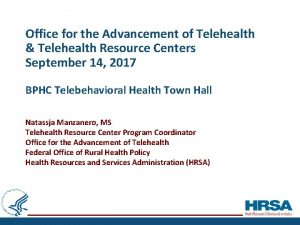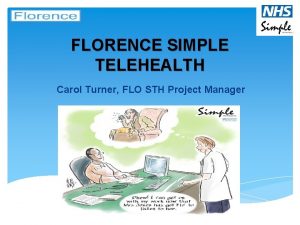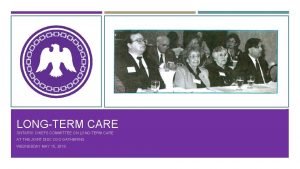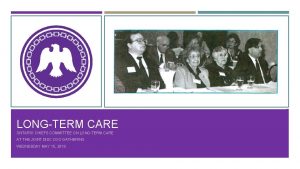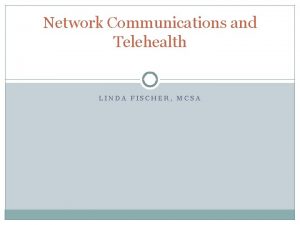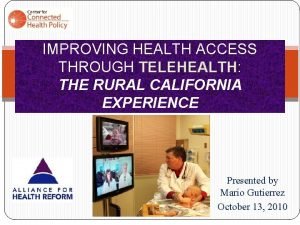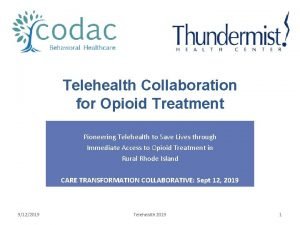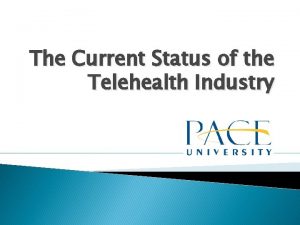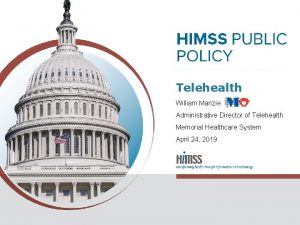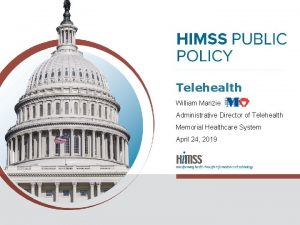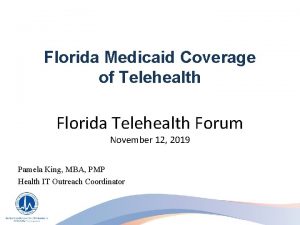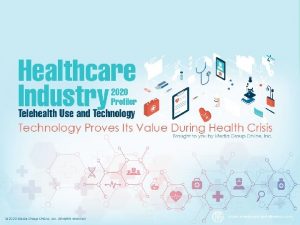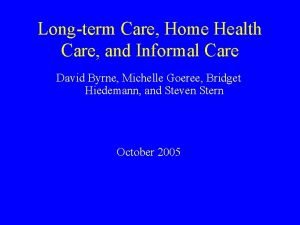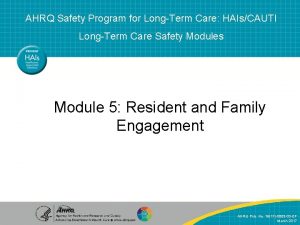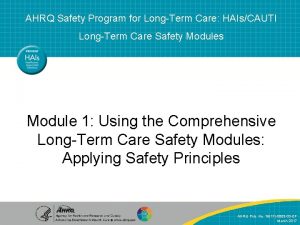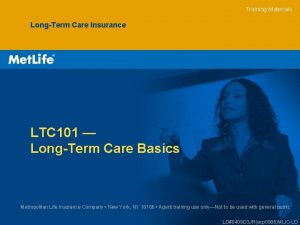TELEHEALTH AND LONGTERM CARE Using Telehealth To Improve





























- Slides: 29

TELEHEALTH AND LONG-TERM CARE Using Telehealth To Improve Care Quality, Health Outcomes, and Cost of Care 2017 Consumer Voice Annual Conference Andrew Broderick, MA MBA Center for Innovation and Technology in Public Health Oakland, California 1

PUBLIC HEALTH INSTITUTE 2

About The Public Health Institute • The Public Health Institute supports evidence-based research and programs as well as policy advocacy to address today’s public health challenges. • PHI drives a diverse body of work that cuts across typical institutional and research silos to improve health and quality of life in California, across the U. S. and around the world. • Learn more at: www. phi. org 3 3

4 PHI internal use only 4 4

PHI: Technology and Innovation At the forefront of promoting technology use to transform public health practices: § Focusing on health equity by examining the role of technology in improving the health of vulnerable and underserved populations. § Evaluating which technologies are effective at improving health outcomes, changing health behaviors and lowering health care costs. § Promoting the adoption of proven technologies by disseminating results to address policy and financing barriers to implementation. 5

THE TELEHEALTH SECTOR 6

7

Telehealth’s Potential Benefits and Reach Telehealth offers the potential to transform healthcare delivery by: § Overcoming geographical distance Peer to Peer § Facilitating timely access Physician to § Improving service efficiencies Physician to Patient And supports the ability to enhance the delivery of services remotely: § Enhancing interaction between professionals § Supporting provider-to-provider training § Enhancing service capacity and quality § Enabling direct patient-provider interaction § Monitoring patient health and activities § Managing patients with multiple chronic conditions 8

Telehealth Services Come in a Variety of Forms TARGET APPLICATIONS § Primary Care § Specialty Consultations SERVICE MODALITIES § Store-and-Forward (asynchronous) § Behavioral Health § Live and Interactive Video (synchronous) § Physical and Occupational Therapy § Remote Patient Monitoring § Home Monitoring § Chronic Disease Management § Health Education § Patient Engagement Mobile Apps USER SETTINGS § Medical Centers § Outpatient Hospital Departments § Physicians Offices § Homes § Schools § Workplaces § Community Service Settings § Wherever Consumer Is 9

With Different Use Cases, Value Propositions, Maturity Levels, and Business Models • Large health systems are developing hospital-based (e. g. , telestroke, tele-ICU, telehospitalist care) and basic care services (e. g. , behavioral health, primary care, case management) for internal use as well as marketing to other entities (e. g. , physician practices) • Commercial insurers are covering telehealth services through contract with vendors in areas of basic medical (e. g. , primary care) and specialty care (e. g. , behavioral health, dermatology, oncology care), and rarely limit use by geographic location or originating site. • Employers are developing their own services for employees or contracting with commercial insurers and health systems to provide these services. Walmart, for example, offers in-store virtual clinics for both employees and customers. 10

Health System Milestones in Telehealth Adoption • Veterans Administration provided telehealth services to more than 702, 000 Veterans during fiscal year 2016, with nearly 45% of visits involving Veterans living in rural areas. • Kaiser Permanente currently provides more virtual encounters (52% in 2016) than inperson encounters through online portals, virtual visits or the health system’s apps. • National Business Group on Health reported that 1/3 of employers offered telehealth behavioral services in 2016, and that 90% planned to make telehealth services available in states where allowed. Source: US Department of Veterans Affairs 11

Consumer Comfort: Live and Interactive Video • Peer to Peer Physician to Physician • Rock Health reports videobased telehealth adoption by consumers more than tripled from 7% in 2015 to 22% in 2016, and 83% of consumers express moderate or extreme satisfaction with the service modality. Physician to Patient A 2017 American Well consumer survey found that twothirds of consumers are willing to see a doctor over video, and that 20% would switch providers if their current doctor does not provideo visits 12

Technology Advances Enabling Telehealth Devices Smartphone Wearables Platform technologies and services for remote delivery of and access to health care resources Desktop PC Advanced Data Analytics Novel sensing devices for monitoring activity, physiology, location, and environmental conditions Sensors & Services Connected Health Tablet Computer Mobile, Apps & Gaming Technologies and strategies to engage consumers in digital behavior change interventions Live Interactive Video Patient Engagement Apps Remote Patient Monitoring 13

Barriers to Telehealth Adoption American Telemedicine Association’s 2017 Leadership Survey reports that inadequate coverage and payments (71%), licensure (53%), and Physician resistance to change (50%) are likely to hinder accelerated growth. to Peer Physician to Physician Patient § Medicare telehealth coverage restrictions limit the geographic and practice settings in which beneficiaries may receive services, while CMS leaves individual states to determine any Medicaid restrictions and limitations. § Commercial insurers have greater flexibility than public payers, but are subject to state law requirements for parity in covered services (although not necessarily the reimbursement amount). § Interstate Medical Licensure Compact introduces a voluntary expedited pathway to licensure for qualified physicians who wish to practice in multiple states. § American Hospital Association recommends lowering the administrative burden and increasing the funding cap of FCC Rural Health Program to ensure 14 that all rural facilities have access to broadband services.

Evidence of Efficacy is Mixed: More Targeted Research Needed Peer to Peer Physician to Patient 15

NQF Evaluation Measures Framework Peer to Peer NQF recommendations for measuring the quality of telehealth services organize measure concepts into six key areas having the highest priority overall for measurement: 1. Travel 2. Timeliness of Care 3. Actionable Information 4. Added Value of Telehealth to Provide Evidence-Based Best Practices 5. Patient Empowerment 6. Care Coordination 16

TELEHEALTH AND LONG-TERM CARE 17

Medicare Payment for Telehealth Services Peer to Peer 18

Telehealth Use in Medicare and Medicaid § Utilization: In 2014 68, 000 Medicare beneficiaries or 0. 2% Part B FFS used telehealth services (500% growth 20082014) § Typical User: Beneficiary tends to be young, disabled, dually eligible and to reside in rural area. § Geographic focus: 10 states accounted for 42% of visits with SD, IA, ND accounting for highest use § Common visits: evaluation and management services (66%) and psychiatric visits (19%) § Drivers: potential to improve or maintain quality, alleviate provider shortages, increase patient convenience. § Barriers: payment, coverage restrictions, and infrastructure requirements. § Medicaid states that are generally more rural than urban 19 use telehealth more frequently.

Medicare Telehealth Requirements Waived for Selected Models and Demonstrations CMS has various efforts underway that have the potential to expand the use of telehealth in Medicare § Peer to Peer Eight models and demonstrations § Certain Medicare restrictions waived § Access in urban areas and homes § Cost-based payments possible 20

Hospital and SNF Use by Medicare Beneficiaries who Reside in Nursing Facilities Peer to Peer § Hospital admission rates of long-stay NF residents are generally declining, but a large degree of variation in rates across facilities suggests opportunities to reduce unnecessary use even further. § Implementation of Medicare’s Hospital Readmission Reduction Program has led to the use of practices to promote care coordination and quality that have led to lower readmissions for PAC beneficiaries § Common practices include medication review and advance care planning, palliative care programs, communication tools, use of NPs to provide direct patient care, telehealth, and skill training for staff. § Implementation of these same care coordination and quality practices that lower readmissions of post-acute care beneficiaries could be used to reduce 21 hospital admissions of long-stay NF residents.

The Evidence Base is Limited but Promising § Hospitalization rates declined 9. 7% in intervention facilities (5. 3% among facilities not receiving the service). § There was a significant decline of 11. 3% in hospitalization rates at facilities that were deemed “more engaged” with the service. § Medicare could expect an average of about $151, 000 in savings per nursing home per year based on the more-engaged facilities, . § The annual cost of the telemedicine service was $30, 000 per nursing home, suggesting that there could be $120, 000 22 in net savings per facility.

Telehealth in Skilled Nursing Facilities Identified 3 Telehealth Applications for SNF settings: Peer to Peer 1. Teleconsultation in Emergency Care—enables a 24/7 consult between SNF staff and emergency department (ED) physician to conduct a patient assessment to determine if an ED visit is necessary 2. Teleconsultation with Specialists—enables remote communication between a SNF provider and specialist for the monitoring, evaluation, and management of clinical conditions 3. Remote Patient Monitoring—enable monitoring of resident safety and wellness through measuring and tracking indicators, including movement, vital signs, and sleep quality, among others. 23

24

The Future of Long-term Care in a review of the future of longterm care over the next decade: Peer to Peer • Post-acute care and telemedicine were noticeable for their absence among the top ten clinical topics found in Pub. Med during 2015. • Technology in the form of telemedicine and the introduction of more functional EHRs are expected to play a major role in the long-term care future. • This will require attention to possible challenges with workflow integration and documentation into electronic record management systems. 25

NH Provider Perceptions of Telemedicine for Reducing Potentially Avoidable Hospitalizations Peer to Peer Physician to Patient Source: 26 Source: Driessen, J. al. “Nursing Home Provider Perceptions of Telemedicine for Reducing Potentially Avoidable Hospitalizations. ” JAMDA

NH Provider Attributes of Telemedicine for Reducing Potentially Avoidable Hospitalizations Peer to Peer Physician to Patient Source: 27 Source: Driessen, J. al. “Nursing Home Provider Perceptions of Telemedicine for Reducing Potentially Avoidable Hospitalizations. ” JAMDA

In Conclusion Key elements in the adoption of telehealth include: § Public Policy § Technology § Research and Evidence-base § Consumer Demand Focus areas promoting implementation at scale: § Comprehensive Coverage § Harmonization of Laws and Regulations § Change Management Practices § Telehealth Integration, Interoperability, Cybersecurity 28

THANK YOU! Andrew Broderick Email: andrew. broderick@gmail. com Telephone: 415. 680. 6024 29
 Lts kernel
Lts kernel Thomas silverstein art
Thomas silverstein art Telehealth and telemedicine
Telehealth and telemedicine Telenursing and remote access telehealth
Telenursing and remote access telehealth Ctel telehealth
Ctel telehealth Office for the advancement of telehealth
Office for the advancement of telehealth Flo telehealth
Flo telehealth Primary secondary tertiary medical care
Primary secondary tertiary medical care Health and social care unit 2
Health and social care unit 2 Restore and improve urban infrastructure
Restore and improve urban infrastructure How to monitor and improve workplace operations
How to monitor and improve workplace operations Accurate cutting facilitates sewing and improve garment
Accurate cutting facilitates sewing and improve garment Asset data to improve cmdbs and it systems
Asset data to improve cmdbs and it systems Protect, promote, and improve the health of all people
Protect, promote, and improve the health of all people Using system.collections
Using system.collections Dtfd switch
Dtfd switch Duty of care care certificate
Duty of care care certificate Magnetii atrag fierul
Magnetii atrag fierul Palliative care versus hospice care
Palliative care versus hospice care Animale care se inmultesc prin oua
Animale care se inmultesc prin oua Care sunt simturile prin care sunt evocate
Care sunt simturile prin care sunt evocate Health and safety standard 13 answers
Health and safety standard 13 answers Hip fracture clinical care standard
Hip fracture clinical care standard Decision making to improve marketing performance
Decision making to improve marketing performance Improve memory latency
Improve memory latency Intrapersonal skill adalah
Intrapersonal skill adalah How to improve current ratio
How to improve current ratio Verbs
Verbs Advertise suffix
Advertise suffix How to improve psychomotor skills
How to improve psychomotor skills





